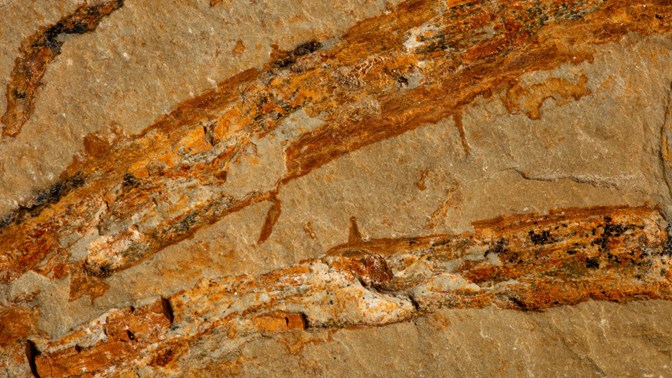400-million-year-old Victorian fossil plant provides new insights into global evolution of land plants
A 400-million-year-old fossil land plant unearthed in Victoria, Taungurungia garrattii, sheds new light on the early evolution of land plants and will be housed at Melbourne Museum.
New research published in The Memoirs of Museum Victoria by scientists from RMIT University describes an entirely new genus and one of Victoria’s oldest fossil plants, demonstrating how plants innovated 400 million years ago to survive and thrive on land.
The fossil was collected from rocks of Early Devonian age by lead author Fearghus McSweeney and Dr Michael Garratt on Taungurung Country near Yea, Central Victoria in 2015, and has been named after the traditional Country on which it was found.
Taungurungia garrattii is one of the earliest known examples of a plant that combines features essential for successful survival on land. The unearthing provides significant new insights into the global evolution of early land plants.
'Taungurungia garrattii is not just about the evolution of Victorian plants – but plants globally, as this group of plants are very rare. This is the first occurrence outside China and suggests this group was more distributed. However, it is entirely possible they are not related and could reflect convergent evolution,' says Fearghus McSweeney.
The plant grew to about 20cm high and featured large, elongated bodies for bearing spores known as sporangia that allowed it to reproduce. This combined with emergences; specialised triangle-shaped bodies for photosynthesis along its stems, were essential for the plant to survive on land and reproduce, where the advantages of newly available habitat and better access to solar energy were offset by harsh sunlight and drying winds.
The combination of large, elongate sporangia with specialised structures for photosynthesis makes Taungurungia garrattii a significant discovery. It is twice the size of similarly aged fossil Yunia dichotoma, which has similar characteristics, from Yunnan, south China. At the time Taungurungia grew on land, the landmasses making up Australia and China were much closer together. Today, each locality is a vital source of information about the early origin and success of land plants.
McSweeney studied the plant as part of his doctoral thesis on early Victorian land plants, painstakingly preparing the fossil over six months. The fossil’s exceptional preservation required the use of fine steel needles and a hand-vice to remove individual tiny grains of silt from the overlying surface. This dégagement revealed delicate structures along its stems, possibly representing buds or sterile sporangia, adding an extra layer of complexity to the plant’s physiology.
The Early Devonian age occurred from 419 million to 393 million years ago, a time when Australia was connected to the Southern Hemisphere's supercontinent, Gondwana. This geological period heralded the evolutionary progress of early land plants, with a dramatic transformation from small, simple ancestors to large and complex organisms that quickly adapted to life on land.
'Taungurungia garrattii was swept out from land and deposited in a marine setting – so we cannot be sure where it grew. However, based on other plants for this period it likely grew either in shallow water or very close to water,' says McSweeney.
The Taungurung Land and Water Council and Taungurung Elders granted McSweeney’s request to name the plant in honour and recognition of Traditional Owners’ continuous stewardship of Country, to which it belongs. The plant’s species name, garrattii, further acknowledges palaeontologist Dr Michael Garratt, for his decades of work advancing the study of ancient land plants in Victoria.
The CEO of the Taungurung Land and Waters Council, Matt Burns, says, 'the Taungurung people are very glad to be acknowledged in the naming of this ancient plant species and we appreciate that the RMIT scientists have thought to do so. And we are proud that this significant scientific discovery has occurred on our traditional lands.'
By naming the genus after the Traditional Owners, McSweeney hopes that it will 'highlight Australia’s Indigenous cultures that have survived longer than any other worldwide, something we should all feel a connection to, and that at a local level that it will encourage people to not just look at the surface, but what is beneath them.'
McSweeney’s research, the first in almost 40 years in this area, has uncovered a number of new species, showing Australia’s flora during this period was a lot more diverse than previously thought. McSweeney hopes this research will be a forerunner for far greater discoveries.
Taungurungia garrattii has been donated to the State’s Palaeontology Collection housed at Melbourne Museum, Victoria. The paper 'Taungurungia gen.nov., from the Lower Devonian of Yea, central Victoria, Australia' is authored by RMIT University scientists, Fearghus McSweeney, Associate Professor Jeff Shimeta, and Professor Emeritus John Buckeridge, and has been published in The Memoirs of Museum Victoria.
For interviews and media enquiries, contact:








